The sectors that will profit most from Asia's long-term growth
Investing in Asia can be difficult. Good Asia funds are thin on the ground. And if you want to pick your own stocks, it's hard to know what to buy and what to avoid, says Cris Sholto Heaton. Here, he picks the four sectors most likely to give investors long-term rewards.

I've often said that most Asia funds don't buy the stocks we want to invest in. But what exactly do we want to buy? Which type of firms will profit the most from the rise of Asia?
This isn't an easy question. We've never dealt with a global economic shift on this scale before. But if we look at past market returns and behaviour and throw in a bit of economic theory, we can come up with some ideas about which sectors are most likely to reward shareholders in the long term.
Of course, there's nothing certain about any of this. Investing is always unpredictable. And we don't have as much good historical evidence as I'd like. But I think the four sectors I've settled on below are among the best candidates.
MoneyWeek
Subscribe to MoneyWeek today and get your first six magazine issues absolutely FREE

Sign up to Money Morning
Don't miss the latest investment and personal finances news, market analysis, plus money-saving tips with our free twice-daily newsletter
Don't miss the latest investment and personal finances news, market analysis, plus money-saving tips with our free twice-daily newsletter
They're certainly likely to be where I invest the most money over the next few years
Look for industries with decent barriers to entry
What kind of stocks should we be looking at? There are all the usual points I've mentioned in the past, of course.
1. Don't forget dividends. Receiving and reinvesting income is the major driver of stockmarket returns over time.
2. Pay attention to value. It's easy to get caught up in a mania and pay too much for glamour stocks.
3. Be aware of corporate governance. In emerging markets, many firms are run for the benefit of a controlling shareholder or family, rather than treating everyone equally.
But above all, we're looking for stocks that combine growth trends with reasonable stability and have some element of monopoly or barriers to entry in their business. Why? In theory, if a sector is delivering excess returns to firms operating in it, then more firms will try to break into the industry, increasing supply and driving down prices and profits.
Like most economic theory, this doesn't work perfectly. It takes a lot more to enter most industries than simply putting up the capital to build a factory. But we can see the basic theory in operation all the time. Look at cyclical industries such as steel and chemicals. These are plagued by over-investment during booms and over-capacity during busts. And with a great deal of investment likely to take place in Asia in the decades to come, competitive forces will be strong.
But if a firm operates in a business which has some barriers to entry, this restricts the extent to which it can be undermined by competitors. That means it will be able to keep its prices higher than they would be under perfect competition, and so make 'excess' profits.
Why you should stock up on shampoo and soap
This can happen in a number of ways. A government-granted outright monopoly; the need to be licensed and regulated; or control over a scarce resource are obvious ones. But perhaps the best for shareholders is firms that are in 'monopolistic competition'.
This means companies that produce very similar products which are differentiated from each other mostly by branding. For example, Colgate and Procter & Gamble both make toothpaste. They have a monopoly over their individual brands, but if one raises its price too high, consumers will switch to the other.
However, consumers display some brand loyalty. So within reason, each firm can defend its market against rivals. And it can charge more for its toothpaste than for supermarket own-brand toothpaste. So brand-name firms can earn excess profits over a long period of time.
Why is this good for shareholders? Well, apart from the profitability, note that these firms' strength lies in their carefully built-up brand. Their success depends on their image which should also encourage the kind of corporate culture that is more likely to treat shareholders well.
Expert tips & advice for investing in Asia! Claim your FREE guides from MoneyWeek that include:
- How to go about investing to Asia
- Which brokers to use to buy foreign shares
These fast-moving consumer goods (FMCGs) which include personal care products, household goods and food, beverages and tobacco have other strong points. Demand tends to be stable, even in recessions. People will put off buying a new consumer durable such as a washing machine, but they'll still buy washing powder for their old one. They'll still drink beer and eat chocolate. This should ensure that these firms stay relatively safe and stable and pay out those steady dividends that we want to reinvest.
Finally and very importantly, growth in demand for these products is likely to be very strong. At the most basic end, there's still a substantial market to be tapped as people move out of poverty. In toothpaste, for example, average consumption in emerging markets is 40% below developed markets, according to Colgate. And as incomes rise, more and more consumers will move into buying higher value products (see chart below).
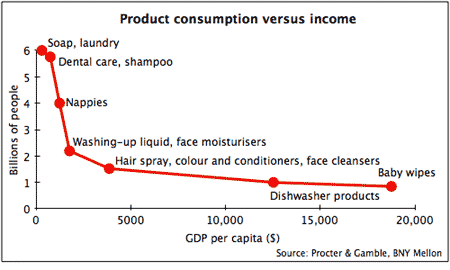
Healthy returns from healthcare
Healthcare seems to offer similar advantages. Such companies depend on earning trust from patients, which again argues for good corporate governance. And barriers to entry are even higher. Any new competitors must contend with regulation, licensing and the limited availability of skilled medical professionals in most markets.
Demand for healthcare is likely to rise strongly as emerging economies become richer. Healthcare spending in emerging Asia is currently around 4%-5% of GDP compared to a typical 8%-10% in the developed world. (Korea, Taiwan, Hong Kong and Singapore are developed countries but are still counted as part of emerging Asia. They've held down healthcare costs through a combination of small size, helpful demographics and well-designed systems to an even greater, but their experience is unlikely to be typical of larger Asian economies in the long run.)
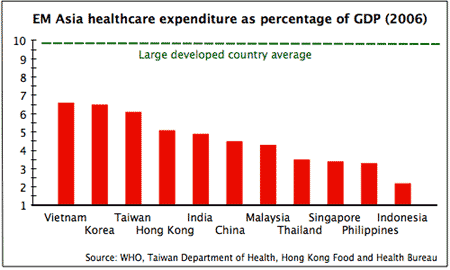
So these two sectors look as though they should do well. But is there any empirical evidence to support this? Well, long-term comparisons are difficult, because index providers only began breaking their benchmarks down by sector relatively recently. But we can see that over the last 30 years, consumer staples was the best performing sector in the S&P 500. Healthcare was second. Both delivered positive returns in all three decades.
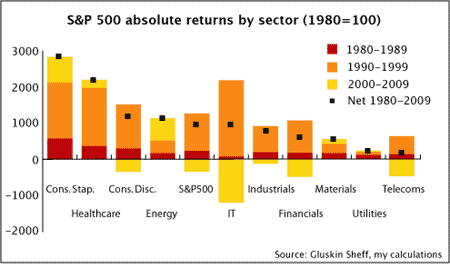
If we look at the relatively short history we have for the MSCI EM Asia, a similar pattern emerges. Over the last 15 years, these sectors delivered healthy returns, in second and third place behind energy.

We can also look back at the Nifty Fifty. These were the stocks that US investors got overly excited about towards the end of the 1960s. They had shown strong growth in the US post-war consumer and industrial booms, and were seen as 'one decision' buy-and-hold stocks. At the peak of the market in 1972, they traded on an average price/earnings (p/e) ratio of around 50, against a p/e of around 19 for the S&P 500.
At that kind of valuation, they were never likely to deliver strong long-term returns. From 1972 to 2001, most underperformed the S&P 500, which had a total return (including reinvested dividends) of 12% over the period. But if you break the stocks down by sector, you can see that two sectors still beat the index overall: consumer staples and healthcare. (The data below actually includes 75 stocks, not 50 there was never a single official Nifty Fifty list.)
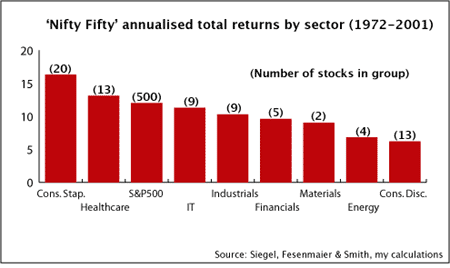
That wasn't because they were a lot cheaper than anything else. On an average p/e of 45, they were pretty much in line. And even if you drop out Wal-Mart - which was an outlier, with an average return of over 25% a year consumer staples still slightly beat the market.
I wouldn't suggest buying any stock on a p/e of 50. But it's interesting that this small sample shows that consumer staples and healthcare were the two sectors that met investors' inflated hopes the best. If you plan to overpay for anything, this may be the safest choice.
Investing in infrastructure
So if you're only going to invest in two sectors in Asia, consumer staples and healthcare would probably be the way to go. But other sectors should deliver decent returns too. Better infrastructure is needed across most of Asia, not least to support these kinds of industries you can't build a national retail chain without decent roads, railways, warehousing and so on.
With infrastructure, there are a couple of obvious things to bear in mind. First, sectors such as power and water have strong monopoly characteristics, but they're very politically sensitive and often subject to regulation and tariff limits. So it's probably better to invest in other, less vulnerable areas.
Second, infrastructure investment is usually capital intensive and depends very little on factors like branding. And if you're putting a lot of capital to work, you need to remember that returns on capital will be greatest where existing capital is scarcest. In other words, you want to invest in infrastructure where the current stock is weak and where this situation is unlikely to change soon.
Putting a figure on infrastructure is tricky. Statistics such as 'number of bridges per square kilometre' don't really tell you much. The chart below shows the World Bank's assessment of EM Asia's logistics infrastructure. As you can see, the developed Asian countries already have excellent facilities.
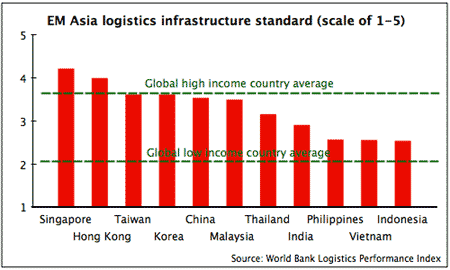
So it makes more sense to look towards investing in countries like India and Indonesia rather than China, where an abundance of state-directed investment means that returns will be much lower.
The coming financial boom
Financials pose a bit of a headache. Clearly, there is vast scope for the emerging Asia financial sector to expand as these economies become richer. For example, credit card use remains very low outside the four developed markets.
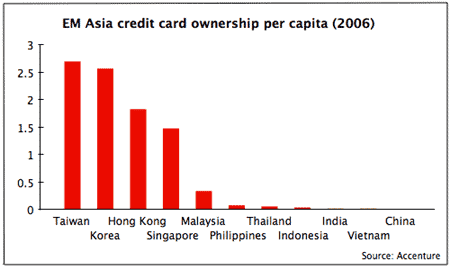
But financials are a cyclical sector with a track record of serious mistakes. They increase lending during a boom and so incur rising bad debts when the bust comes. So you need to be selective. Focus on well-managed, prudent institutions and try to avoid the gung-ho ones who do well for a few years then burn out. In particular, all Chinese banks look very risky which is something I'll look into in more detail in a future article.
What not to buy
Telecoms is a tricky one. The mobile sector has great growth potential. But it's a fairly capital-intensive business which is prone to price wars. There's value in countries such as Indonesia where competition is falling, but you should avoid the likes of India, where rivalry is hotting up.
Sectors such as IT and industrials can produce highly successful companies with a strong market position. If Asia is to have a bigger influence, it will need to produce more global heavyweights in these areas. 'Emerging multinationals' should be a theme worth investing in, but bear in mind that competition and innovation can overturn formerly dominant firms surprisingly quickly.
I'd steer clear of industries such as chemicals and steel altogether. They're highly cyclical, prone to overinvestment and likely to destroy value over the long run. I'm not enthusiastic about carmakers or airlines either. Both have a track record of overcapacity and political interference.
And I'd be very cautious about real estate. It's highly cyclical. And developers have always shown appalling financial discipline. They overbuild and pile on too much debt in every boom, then struggle in every bust. High-quality property in markets where space is likely to be constrained in the long run, such as Singapore logistics or Hong Kong offices, look far more attractive than flats in Shanghai.
Know when to sell
Of course, all of this is focusing on the long term. There's nothing wrong with investing in other stocks when the time is right. But with cyclicals, you want to buy when everyone hates them and sell when they've recovered. That generally means buying in the middle of a recession, not when markets are up 90% or so from last year's bottom.
Take Kingboard Chemical Holdings. I suggested bottom-fishing for cheap Chinese manufacturers back in January 2009 and suggested this printed circuit board firm as a good candidate. It's now up a healthy 155%, versus 40% for the Hang Seng Index.
I've been in two minds about whether to hang on to the stock or not. It has a strong position among Chinese firms. And it could grow into a far more significant global player. But it is a cyclical business, and when a stock like this has run much further than you expect, it makes sense to take profits.
On top of this, the firm is planning to significantly expand its property investments. This suggests a worrying lack of focus on its core business a common problem with emerging market firms. So if you bought the stock, I'd suggest that now's time to take profits.
This article is from MoneyWeek Asia, a FREE weekly email of investment ideas and news every Monday from MoneyWeek magazine, covering the world's fastest-developing and most exciting region. Sign up to MoneyWeek Asia here
Get the latest financial news, insights and expert analysis from our award-winning MoneyWeek team, to help you understand what really matters when it comes to your finances.
Cris Sholto Heaton is an investment analyst and writer who has been contributing to MoneyWeek since 2006 and was managing editor of the magazine between 2016 and 2018. He is especially interested in international investing, believing many investors still focus too much on their home markets and that it pays to take advantage of all the opportunities the world offers. He often writes about Asian equities, international income and global asset allocation.
Cris began his career in financial services consultancy at PwC and Lane Clark & Peacock, before an abrupt change of direction into oil, gas and energy at Petroleum Economist and Platts and subsequently into investment research and writing. In addition to his articles for MoneyWeek, he also works with a number of asset managers, consultancies and financial information providers.
He holds the Chartered Financial Analyst designation and the Investment Management Certificate, as well as degrees in finance and mathematics. He has also studied acting, film-making and photography, and strongly suspects that an awareness of what makes a compelling story is just as important for understanding markets as any amount of qualifications.
-
 ‘Why I have ditched my Help to Buy ISA for cash savings and the stock market’
‘Why I have ditched my Help to Buy ISA for cash savings and the stock market’Without the 25% bonus, my Help to Buy ISA is effectively redundant, says MoneyWeek writer Sam Walker.
-
 Is your inheritance tax allowance cut if you sell to downsize or sell your home to pay for care?
Is your inheritance tax allowance cut if you sell to downsize or sell your home to pay for care?Downsizing relief is a little-known benefit that could save your loved ones tens of thousands of pounds in inheritance tax after you’ve died.
